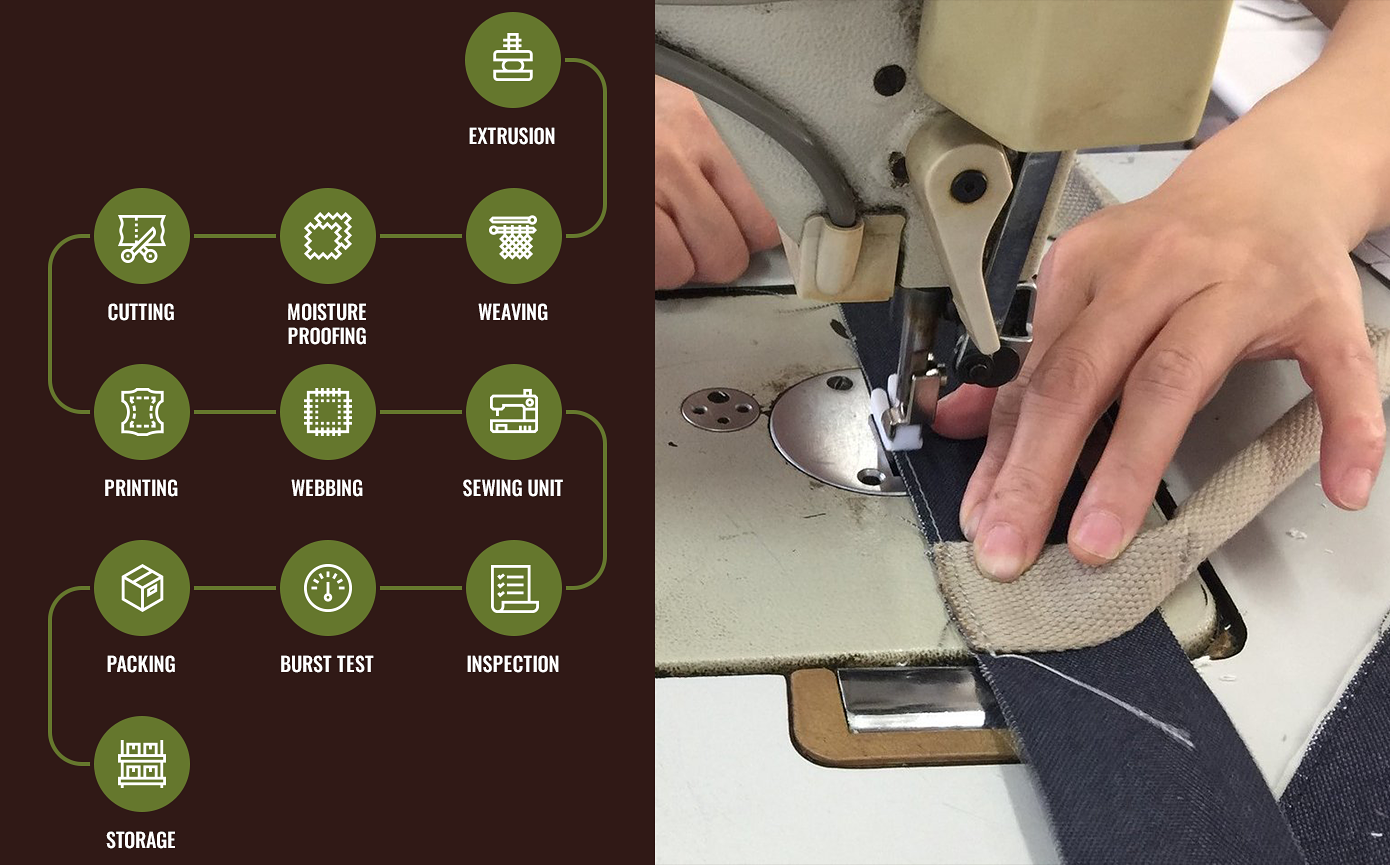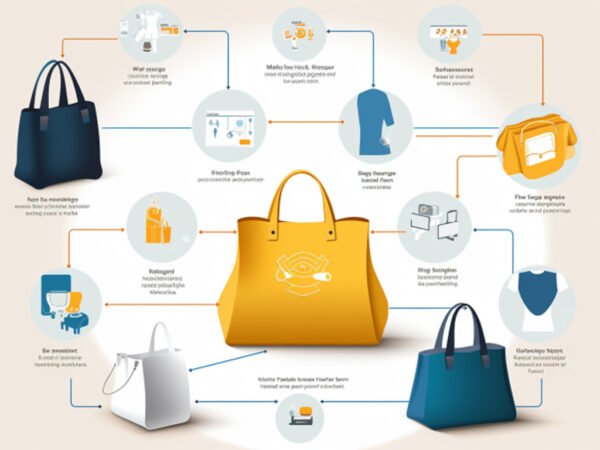The tote bag manufacturing process transforms raw leather into a functional work of art through design, pattern making, cutting, assembly, and finishing.

A well-crafted leather tote bag is more than an accessory; it’s a reliable companion built through a meticulous process that blends traditional artistry with precision engineering. The journey from a simple concept to a finished product involves a series of deliberate stages, each critical to the final quality and durability of the bag. Understanding these steps reveals the immense skill and attention to detail required to create a truly exceptional piece.

Table of Contents
- What Are the Foundational Steps in Creating a Leather Tote Bag?
- The Genesis of Design: Conceptualization and Prototyping
- Selecting the Soul of the Bag: The Art of Choosing Leather
- The Precision of the Cut: Pattern Making and Leather Cutting
- The Art of Assembly: Stitching and Construction
- The Finishing Touches: Bringing the Tote Bag to Life
- Why Does a Handcrafted Process Matter?
What Are the Foundational Steps in Creating a Leather Tote Bag?
Creating a leather tote bag is a systematic journey that begins long before the first piece of leather is cut. It starts with an idea—a vision for a bag that is both beautiful and functional. This vision is then translated into a tangible design, refined through prototyping, and brought to life using carefully selected materials. The core stages include designing the bag’s structure, choosing the right leather, creating precise patterns, cutting each component, meticulously assembling the pieces, and applying final finishing touches. Each step builds upon the last, ensuring the final product is not only aesthetically pleasing but also structurally sound and capable of withstanding the rigors of daily use. This transformation from raw hide to polished accessory is a testament to the skill of the craftsperson.

The Genesis of Design: Conceptualization and Prototyping
Every great tote bag begins as an idea. This initial phase is where creativity and practicality converge to define the bag’s identity and purpose. It involves translating abstract concepts into a concrete blueprint that will guide every subsequent step of the manufacturing process.
From Inspiration to Blueprint
Inspiration for a new tote bag design can come from anywhere: the clean lines of modern architecture, the functional needs of a daily commuter, or the timeless appeal of a vintage piece. The initial goal is to define the bag’s core function. Will it be a spacious carry-all for work, complete with a laptop sleeve? Or perhaps a lightweight, open-top bag for weekend errands? Once the purpose is clear, designers begin sketching, creating initial drawings that outline the bag’s silhouette, proportions, and features. These sketches are then often refined using computer-aided design (CAD) software, which allows for precise measurements and detailed 3D renderings, ensuring every pocket, strap, and seam is perfectly planned before production begins.
Crafting the First Prototype
A digital design, no matter how detailed, cannot fully capture the feel and function of a physical object. This is why prototyping is an indispensable stage. A prototype, or sample bag, is created using less expensive materials to test the design in the real world. This physical model allows artisans to assess critical elements like weight distribution, strap comfort, accessibility of compartments, and overall structural integrity. The prototype is handled, filled, and carried to identify any potential flaws or areas for improvement. Adjustments are made, and the process may be repeated until the design is perfected. This iterative refinement ensures that the final product is not only beautiful but also ergonomic and intuitive to use.
Selecting the Soul of the Bag: The Art of Choosing Leather
The choice of material is arguably the most critical decision in the creation of a premium tote bag. The leather selected determines the bag’s durability, appearance, and how it will age over time. It is the very foundation upon which the bag’s character is built.
Why Full-Grain Leather Reigns Supreme
At Beldțuraleather, our commitment to longevity begins with our material choice. We exclusively select premium full-grain leather, which is the highest quality grade available. Sourced from the outermost layer of the hide, full-grain leather retains its natural surface, including all the unique markings and textures. Unlike corrected grades, it isn’t sanded or buffed to remove imperfections. This integrity makes it incredibly strong and durable. Over time, full-grain leather develops a rich patina—a soft sheen that emerges through use—making each bag a unique piece that tells the story of its owner’s journey. This graceful aging process ensures that a well-made tote doesn’t just last; it gets better with age.
Understanding Different Leather Grades
Navigating the world of leather can be complex. To demonstrate the difference in quality, it’s helpful to compare the most common types of leather used in bag manufacturing. The right choice impacts everything from the bag’s feel to its lifespan.
| Leather Grade | Characteristics | Durability | Aging Process |
|---|---|---|---|
| Full-Grain | Top layer of the hide with natural grain and markings intact. The most authentic type of leather. | Highest | Develops a rich patina; becomes more beautiful over time. |
| Top-Grain | The second-highest grade. The surface is sanded and finished to remove imperfections. | Very Good | Ages well but does not develop the same character or patina as full-grain. |
| Genuine Leather | Made from the lower layers of the hide. The surface is often treated, painted, or embossed. | Moderate | Does not age well and can show wear more quickly. Lacks the strength of higher grades. |
The Precision of the Cut: Pattern Making and Leather Cutting
With a finalized design and selected leather, the next stage involves translating the blueprint into physical components. This requires immense precision, as even the slightest error in cutting can compromise the structure and appearance of the entire bag.
Creating the Master Pattern
The master pattern is the set of templates used to cut the leather for each part of the tote bag. Based on the finalized prototype, these patterns are meticulously crafted from durable materials like cardboard or acrylic. Each piece—from the main body panels and base to the straps, pockets, and small reinforcements—must be perfectly shaped and measured. The pattern maker’s job is a blend of geometry and artistry, ensuring that all pieces will fit together flawlessly during assembly. These templates serve as the definitive guide for creating a consistent and well-proportioned product.
Techniques for Cutting the Hide
Cutting leather is a skill that demands a steady hand and a keen eye. Before any cut is made, the craftsperson inspects the entire hide, noting its unique grain and identifying any natural blemishes that should be strategically avoided or incorporated. For one-of-a-kind or small-batch production, cutting is often done by hand using an extremely sharp round knife. This traditional method allows the artisan maximum control to work around imperfections and select the best sections of the hide. For greater consistency, a hydraulic clicker press can be used with steel dies shaped to the pattern pieces. This ensures every component is cut with perfect uniformity, which is crucial for efficient assembly.
The Art of Assembly: Stitching and Construction
This is the stage where individual, flat pieces of leather are transformed into a three-dimensional, functional tote bag. The assembly process is a careful sequence of preparation, joining, and reinforcement, where strength and aesthetics must work in perfect harmony.
Preparing the Pieces for Assembly
Before stitching can begin, the cut leather components must be prepared. An essential technique is skiving, which involves carefully thinning the edges of the leather where seams will be joined. This prevents bulky, uneven seams and allows the pieces to sit flush against one another, creating a clean and refined look. After skiving, stitch lines are often marked or creased onto the leather surface. This ensures that every stitch is perfectly straight and evenly spaced, a hallmark of high-quality craftsmanship.
The Unbreakable Bond: Hand Stitching vs. Machine Stitching
The method used to stitch a bag together is a defining factor in its durability. Many high-end, handcrafted bags utilize a technique called the saddle stitch. This traditional method, done by hand with two needles, creates an interlocking stitch that will not unravel even if one thread breaks. It is significantly stronger and more time-consuming than a typical machine lockstitch. While industrial sewing machines offer speed and efficiency, the enduring strength of a Beldțuraleather tote lies in its meticulous, time-honored stitching techniques that prioritize resilience above all else. Proper thread tension, stitch length, and needle choice are all critical variables that the artisan must master.
Hardware and Reinforcements
The final steps in construction involve adding hardware and reinforcing areas that will bear the most stress. This includes solidly attaching solid brass or stainless steel rivets, buckles, D-rings, and zippers. Key stress points, such as where the straps connect to the bag’s body, are often reinforced with extra layers of leather or hidden stitching to prevent tearing over years of heavy use. Every piece of hardware is chosen not just for its appearance but for its strength and resistance to corrosion, ensuring it functions reliably for the life of the bag.
The Finishing Touches: Bringing the Tote Bag to Life
The final stage of manufacturing is dedicated to refinement. These finishing details are what elevate a well-made bag into an exceptional one, showcasing a commitment to perfection down to the smallest element.
Perfecting the Edges
Exposed leather edges can be a telling indicator of a bag’s quality. Rather than leaving them raw, a master craftsperson will engage in burnishing. This intensive process involves sanding the edges smooth, beveling them to a slight curve, and then applying water or a natural gum agent. The edge is then rubbed vigorously with a smooth tool, using friction to heat, seal, and polish the leather fibers into a durable, glossy finish. Alternatively, some modern designs use a special edge paint, which is applied in multiple layers to create a clean, uniform, and highly durable seal.
Conditioning and Final Inspection
Once fully assembled, the tote bag receives a final treatment. A high-quality leather conditioner or wax is applied to nourish the hide, enhance its natural luster, and provide a layer of protection against moisture and dirt. This step ensures the leather is supple and ready for its new owner. The bag then undergoes a rigorous final quality control inspection. Every stitch, rivet, seam, and surface is meticulously examined to ensure it meets the highest standards of craftsmanship. Only after passing this final check is the bag deemed ready for its journey.
Why Does a Handcrafted Process Matter?
In a world of mass production, the dedication to a meticulous, hands-on manufacturing process results in a product of superior quality and character. Each step—from the thoughtful selection of a full-grain hide to the patient work of saddle stitching—contributes to a tote bag that is not merely an object, but a durable and personal artifact. The natural variations in the leather mean that no two bags are exactly alike, each possessing its own unique identity. This deliberate and artful journey from raw material to finished good is the essence of every bag we create at Beldțuraleather, ensuring it becomes a trusted companion for life, not just a fleeting accessory for a season.



